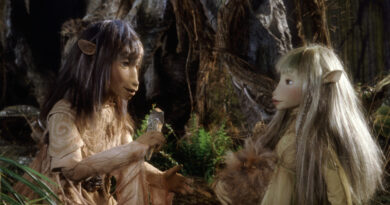Beetlejuice Beetlejuice (2024)
Beetlejuice Beetlejuice is the most Burtonesque film Tim Burton has made in a long time – perhaps since his original Beetlejuice was released in 1988, when he was still making a name for himself with his unique aesthetic. To see this film is to watch a filmmaker returning to his roots, and, on the basis of the visuals, having a great deal of fun doing it. And it rubbed off; it’s the most fun I’ve had at a movie theater in many a moon. Like its predecessor, it’s a funny, ghoulishly wacky romp through the macabre, all filtered through the intentional falseness of seasonal Halloween superstores and carnival spook houses. Its gore isn’t too gory, the makeup and special effects walk the line between stylistically lowbrow and just plain cheap, and several scenes are lit with neon and UV lights.
For better or worse, the cult status of the 1988 film ensured many insider references and throwbacks would feature in the 2024 film. This goes beyond the cast, including Michael Keaton, Winona Ryder, and Catherine O’Hara; undead characters with shrunken heads answer telephones in one of several bureaucratic afterlife services, the Handbook for the Recently Deceased factors into the story, claymation sand worms on a moon of Saturn are included, and the living will be possessed and forced to dance to an old song – although it’s not “Day-O (The Banana Boat Song)” this time around, and it’s not at a dining room table. Some new things are thrown in; among other things, we see new afterlife departments, including an immigration center and a subway station with a literal soul train, and Burton shows us his love of Mario Bava films.
The plot: Lydia Deetz (Ryder), now a neurotic mess who hosts her own paranormal talk show in New York, returns to the former Maitland house in Winter River, Connecticut after the untimely death of her father, played in the first movie by Jeffrey Jones. For obvious reasons, only Jones’ likeness appears in the sequel. His character, however, still has a part to play, and of that, I’ll say no more. Anyway, as if her father’s funeral weren’t stressful enough, she has to contend with: (1) Her stepmother Delia (O’Hara), who has only grown more arty and pretentious since her sculpting days; (2) her manager fiancé (Justin Theroux), who barely hides his obvious scheme to exploit and profit off of Lydia behind manipulations and New Age word salads; and (3) her uncontrollable ability to see the dead, which unfortunately hasn’t included her late ex-husband.
All this has made her teenage daughter Astrid (Jenna Ortega) bitter and resentful – not at all unlike Lydia was back in 1988. Through a subplot I won’t give away, she finds herself trapped and in danger in the very afterlife world she never believed existed. If Lydia is to save her, she has no choice but to rely on the one ghost she never wanted to see again, the obnoxious and disgusting Betelgeuse (Keaton). He’s in a pickle of his own, and needs Lydia’s help in return; not only is he wanted by the afterlife police, led by a former action-movie actor now missing half of his head (Willem Defoe), he’s being hunted by his ex-wife (Monica Bellucci), a jealous and possessive woman with the ability to suck out souls, even from creatures that are already dead.
There’s a lot going on here, more than I would have expected from a Beetlejuice sequel. And believe me, that isn’t everything that happens. Still, never once does Burton allow the plot to become confusing; even with a glut of details, I was able to follow along and make sense of it all – as much sense, at any rate, one can make of a goofy horror comedy. Most of all, I was able to have a good time. I wasn’t looking for meaning or subtext, and I certainly wasn’t interested in an argument over which movies can and cannot be considered “art.” That kind of thing has its place, no question. Still, the films of Tim Burton have so rarely received acclaim, and I suspect that stems largely from the more snobbish critics who consider popular entertainment an evil cinematic blight.
At the very least, give him credit for his established visual style and being the most true to it since his 2012 stop-motion animated remake of Frankenweenie. Nowhere is this more apparent in Beetlejuice Beetlejuice than with the Bellucci character, introduced in literal pieces before stapling herself back together, and thus spends most of the movie with metal stitching makeup all over her body; if we know anything about Burton’s design work, it’s that stitched skin sits alongside stripes and cartoon characters with huge heads and eyes as his favorite motif, especially on women with clown-white skin. You see her and immediately think she’s the dark and evil twin sister of Sally the rag doll from The Nightmare Before Christmas.




